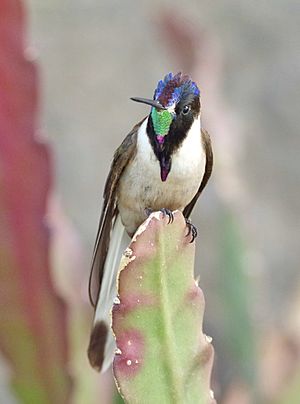Bearded mountaineer facts for kids
Quick facts for kids Bearded mountaineer |
|
|---|---|
 |
|
| A bearded mountaineer in Ollantaytambo, Peru on December 5, 2015. | |
| Conservation status | |
| Scientific classification | |
| Genus: |
Oreonympha
|
| Species: |
nobilis
|
 |
|
The bearded mountaineer is a special type of hummingbird that lives only in Peru. It's also sometimes called the eastern mountaineer. Its scientific name is Oreonympha nobilis. This amazing bird is known for its unique look, especially the male's colorful "beard."
Contents
About the Bearded Mountaineer
The famous bird expert John Gould first described the bearded mountaineer in 1869. He gave it its own special group, Oreonympha. Scientists have studied this hummingbird to understand its family tree. They found it is closely related to other hummingbirds like the bearded helmetcrests.
There are two main types, or subspecies, of the bearded mountaineer. One is called O. n. nobilis and the other is O. n. albolimbata. Some bird experts even think these two types might be separate species!
What Does It Look Like?
The bearded mountaineer is about 14 to 16.5 cm (5.5 to 6.5 in) long. This includes its bill, which is about 2.3 cm (0.91 in) long. It weighs around 7 to 9 g (0.25 to 0.32 oz), which is very light!
The adult male of the O. n. nobilis type has a deep purplish-blue head. It has a thin black stripe down the middle. Its face is dark with a narrow white band at the back. The male's most striking feature is its long, narrow "beard," called a gorget. This gorget is emerald green under the chin and purplish with a blue tip.
The back and rump are bronzy-brown. Its tail is long and deeply split, like a fork. The tail feathers are bronzy, with more white towards the outer edges. The chest is white in the middle, with brownish sides.
Female bearded mountaineers look similar to males but are not as brightly colored. Their gorget is smaller and mostly white. Their tail is also less deeply forked. Both males and females have black bills and legs. Young birds are duller than adults. They have a scaly green head and a dull brown throat.
The O. n. albolimbata subspecies has white bands on the sides of its head. Its tail is also more coppery. The female of this subspecies has white extending from these head bands to her throat.
Where Does It Live?
The "eastern" bearded mountaineer (O. n. nobilis) lives in south-central Peru. You can find it in the Apurímac and Cuzco areas. It lives near the Urubamba and upper Apurímac rivers.
The "western" type (O. n. albolimbata) lives in other parts of Peru. These include the Huancavelica, Ayacucho, and Apurímac areas. It lives near the Mantaro, Pampas, and Chalhuanca rivers.
This hummingbird makes its home in dry Andean valleys. These areas have rocky hillsides and open woodlands. It lives among different native plants. You can also spot it near tree tobacco plants and Eucalyptus trees. Sometimes, they are even found along roads and in towns. They live at high elevations, from 2,500 to 3,900 m (8,200 to 12,800 ft) above sea level.
How Does It Behave?
Movement
The bearded mountaineer stays in the same area all year round. It does not migrate.
Feeding
This hummingbird mostly sips nectar from flowers. It especially likes nectar from Agave plants, cacti, Nicotiana (tree tobacco), and Eucalyptus trees. It feeds by hovering in the air with its body almost straight up. It also clings to flowers with its wings open. Besides nectar, it also eats small insects. The bearded mountaineer is usually shy around other hummingbirds.
Breeding
Scientists don't know much about how the bearded mountaineer breeds. One early observer thought they might build nests in caves above rivers.
Sounds It Makes
The bearded mountaineer makes a few different sounds. Its calls include a "descending, squeaky series." This is followed by a rich chattering sound, like "swee swee chew-chew-chew." It also makes a dry "dzzrt" sound.
What Is Its Status?
The IUCN (International Union for Conservation of Nature) keeps track of how many animals are left. They consider both types of bearded mountaineers to be of "Least Concern." This means their populations are not currently in danger.
Even though they live in a small area, their numbers are thought to be stable. This bird is described as uncommon to common in different places. It's possible that human-planted Eucalyptus and tree tobacco trees help them if their natural homes are lost.
See also
 In Spanish: Colibrí noble para niños
In Spanish: Colibrí noble para niños


